Survey of Sustainable Development to Make Great Man-Made River Producing Energy and Food
Mohamed Nasar Nasar1 *
Corresponding author Email: hamde_1983@yahoo.com
DOI: http://dx.doi.org/10.12944/CWE.10.3.05
The Great Man-Made River (GMR) is the world largest irrigation project, consisting of a network of pipes that supplies water from Libyan desert in the south to the coastal areas in the north. This paper studies the possibility of taking advantage of GMR to generate energy and produce food through agriculture. Hydro-kinetic power generation would be carried out by generating energy from water movements across Great Man-Made River pipelines using appropriate sizes of turbines. It's known that the length of the GMR pipeline is about 4000 km with a diameter of 4 m. Pipeline of such magnitude with great water flow rate would make a turbine to produce hundreds of Kilowatts of clean energy. The most significant reasons that force us to take advantage of GMR to generate energy are: a) The needs to sustainable environmental energy source; b) Power System uses energy of flowing water to provide a consistent, controllable, non-weather-dependent source of electricity, such as other types of renewable energy, which are depend on the weather. The conversion of GMR, from supplying freshwater to coastal cities, to huge agricultural project after the establishment of many seawater desalination plants (solar powered) would cover the needs of cities for fresh water. Thus it would become possible to convert thousands of desert hectares around the pipelines to huge agricultural project irrigated from GMR.
Copy the following to cite this article:
Nasar M. N. Survey of Sustainable Development to Make Great Man-Made River Producing Energy and Food. Curr World Environ 2015;10(3) DOI:http://dx.doi.org/10.12944/CWE.10.3.05
Copy the following to cite this URL:
Nasar M. N. Survey of Sustainable Development to Make Great Man-Made River Producing Energy and Food. Available from: http://www.cwejournal.org/?p=13019
Download article (pdf) Citation Manager Publish History
Select type of program for download
| Endnote EndNote format (Mac & Win) | |
| Reference Manager Ris format (Win only) | |
| Procite Ris format (Win only) | |
| Medlars Format | |
| RefWorks Format RefWorks format (Mac & Win) | |
| BibTex Format BibTex format (Mac & Win) |
Article Publishing History
| Received: | 2015-07-24 |
|---|---|
| Accepted: | 2015-10-21 |
Introduction
The North African state of Libya is in one of the driest regions of the world with an annual rainfall ranging from just 10 mm to 500 mm. Just 5% of the entire area of Libya exceeds 100 mm annually. Evaporation rates are also high, ranging from 1,700 mm in the north to 6,000 mm in the south.1
Some of British researchers have found that Libya is floating on the vast reserves of groundwater, and they have assigned the amount of groundwater/aquifers that Africa has. The reserve of ground water in Africa is one hundred times more than the water amount on its surface, the largest amount has found in sedimentary aquifers in north of Africa (Sudan, Algeria, Libya, Egypt), a lot of groundwater’s located underground in depth of 100 – 250 m.2
To overcome the serious shortages of water and avert an impending crisis, the Great Man-Made River (GMR), transports fossil water from the vast Nubian Sandstone Aquifer System in the south of Libya, northwards to the populated coastal cities. The project's construction was divided into five phases. The first and second phases were already established (Fig. 1).3,4 In 1983, GMR was originally intended to supply 67% of the agricultural sector’s needs. It provides about 75% of Libya’s annual water demand (urban plus agriculture), from 1,000 wells, through 4,000 km of buried 4-meter-diameter pipe, with some surface water impoundments for interim water storage.5 GMR carries water (about 6 million cubic meters a day) from groundwater systems in south east (Kufra and Sarir) and groundwater systems in south west (Murzag).6
Gravity, pumping water from 1,000 wells and increasing the length of the pipeline in distance are consume much fuel, which are exorbitant and will become more costly as global oil prices rise. Every barrel of oil needed for pumping, costs Libya US$90 or more in foregone exports. This is one of the reasons that lead us to look for and find the sustainable solutions to the problem of energy consumption, financial cost and environmental cost.
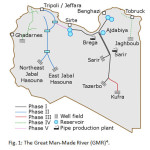 |
|
GMR hydro-kinetic Power Generation
Conduit hydro-electricity (or conduit hydropower) is a method of using hydro-kinetic energy as part of the water delivery system through GMR conduits to generate electricity.7
It's known that the length of the GMR pipeline is about 4000 km and 4 m in pipe diameter. We can take advantage of water flow rate and speed by installing suitable (size and specification) turbines customized for electric power generation inside GMR pipe to generate electricity.
It is bright the amount of energy that will be generated by approximately 2000-4000 turbines. They could be installed every 0.5 km or every 1 km along pipeline according to the possibilities available and sustainable development plans.
Hydro-kinetic Power Generation Related Work
Hydro-kinetic power generation still being tested in a riverside public utilities water pipe. A spherical turbine (Fig. 2) was installed in the public utilities water pipe, this turbine generates 20 kilowatts, which's enough for 10 average households or to light five to six miles of streetlights at night.8
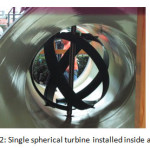 |
|
Not as the other technologies of renewable energy sources, power system uses the energy which's generated from flowing water to give appropriate, under control and non-weather dependent source of energy that could be used in different areas; such as supporting public grid to reduce costs and get new sources of income. LucidPipe utilizes, pipe turbine that captures energy from fast-moving water inside of large diameter, gravity-fed pipelines, with no impact on flow or operation. Depending on head pressure, flow and pipe diameter. The amount of generated energy depends on the rate flow and the pressure inside the pipeline. For example, in 1.5 m diameter pipe, flow speed of 2 m/s and 28 m of head (2.76 bar), a unit of LucidPipe will generate 100 Kw of energy as well as extract 3.5 m of head (0.345 bar) from the system. By adding many turbines in the pipeline with the aforementioned properties these turbines will generate thousands of megawatts of renewable energy without impact on the environment. Fig. 3 shows hydro-kinetic power generation using multiple turbines in a pipeline.9
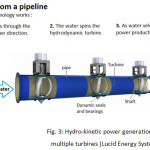 |
|
Rentricity focuses on hydro-kinetic power generation in a pipe. Water flows through pipelines to generate electricity year-round with 24 hours per day. Rentricity has developed energy recovery systems to convert the excess pressure which produced from pressure reduction valves (PRVs) into clean electricity as seen in Fig. 4. Rentricity runs two in-pipe hydro energy recovery systems, Flow-to-Wire™ (Rentricity Inc. New York, USA), for 30 kW to 350 kW, and launched plug-and-play Sustainable Energy and Monitoring Systems (SEMS™), for applications in the 5 kW to 30 kW range. The generated electricity could be used to support public grid or get new source of income. However, the systems can be merged with already existing SCADA (supervisory control and data acquisition) systems to give transparency over control system.10
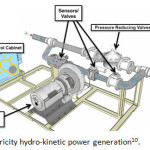 |
|
How Hydro-kinetic Power Generation Works
This technique utilizes, based on turbine installed inside of 4 m diameter of water pipes. Water will flow through the hydrodynamic turbine to generate energy as the turbine rotates. The hydrodynamic turbine has been designed to maximize efficiency and energy without interrupting the flow of water. Energy generation is proportional to the water speed, as water flow speed increase, energy generation will increase. This process extracts very little head pressure per turbine, just 0.07-0.41 bar. This allows the modular system to be installed in series to uninterrupted water flow.
Pipe diameter, water flow rate, water velocity and head pressure are factors that help to determine the optimized size and specifications for turbines those will operate in the pipeline. Performance and reliability achieved by LucidPipe turbine at velocity greater than 1.22 m/s.9
According to,9 the average rate of water flow in GMR pipe is of 120 L/s per well,11 about 1,000 wells distributed almost equally between two GMR branches, so 500 wells will produce 60000 L/s through GMR pipe diameter of 4 m, in other hand each branch will produce 646 m3/s through GMR pipe diameter of 4 m. Such tube with this diameter and great water flow rate will make one turbine produces hundreds of kilowatts of energy.
Benefits of Power Generation over GMR
The benefits of this project are as follows:
- Get clean energy, safe, sustainable and considered one of the renewable energy sources.
- Considered as new and innovative resource for power generation, all the researches and studies were interested in solar energy as the only alternative to fossil fuels in Libya.
- Increase the diversity of energy sources, so energy sources in the country will be increased as the promotion of its economic strength and its national security.
- Contribute to the reduction of the volume of the consumption of fossil fuels which currently used in power generation, thus reducing the rate of greenhouse gas emissions and preservation of fossil fuel reserves.
- Increase the integration of GMR project, to obtain the necessary energy to run hundreds of pumps by relying on himself.
- Create employment opportunities that will improve living standard and revive the economy.
Transformation of GMR to Largest Global Agricultural Project
The idea is to transform GMR to huge agricultural project instead of supplying fresh water, after establishment of several water desalination plants solar-powered to provide fresh water needs to coastal cities. GMR penetrates Libya from south to north and from east to west along the coast with a length of 4000 kilometers, like a real river and we can transform the desert lands in both sides of the pipeline, which are estimated thousands of hectares to huge agricultural project irrigated from GMR water (Fig. 5).
This project needs some uncomplicated mechanical measurements, which will take place on the main pipeline to transport water to the target lands as following:
- Creation of large water tanks beside the main pipeline, the size of these tanks are depend on agricultural reclamation lands according to sustainable plans and placed at appropriate distances to provide piping water to farms.
- Creation of subnet pipes which are extend from tanks to the target lands.
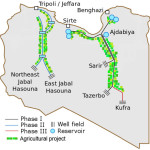 |
|
Benefits of Agriculture over GMR
Agriculture project is one of the most important development projects with following benefits:
- Reclamation of thousands of desert hectares on both sides of the GMR pipeline.
- Enhancing food security and self-sufficiency from agricultural crops.
- Expand GMR pipeline for hundreds of kilometers, from south to north across different climatic zones (Mediterranean Sea and the desert),12 this contrast in climate will allow to plant different agriculture crops.
- Create employment opportunities to thousands of employees that will increase income level.
- Create multi-purpose factories for light industries and other medium-heavy such as establishment of canning factories, packaging of agricultural products and tomato paste and oil factories, ...etc.
- Significant contribution to the diversification of income sources. It is well known that Libya relies on oil and gas revenues significantly at the moment. it is good to Libya to become an agricultural country to produce and export various agricultural crops.
- Stop migration from countryside to cities, fight against desertification and solve obsessed with food security and creation of stable economic and development for the post-oil.
- Establishment of new cities and urban communities in places considered repellent to population.
- Increasing green spaces which help to improve the climate.
Conclusion
In focus of growing global interests in renewable energy resources to reduce pollution and greenhouse gas emissions, governments looking forward to develop new resources of clean energy.
Libya is not out of this world, it is seeking in recent years, especially after the revolution of 2011 for investments and development of renewable energy resources, such as establishment of seawater desalination plants to supply fresh water to coastal cities, solar and wind energy.....etc. to reduce total reliance on fossil fuel as main source of energy. Under these circumstances, encouraging in the field of sustainable development, the focus now is shifting more and more towards the renewable sources of energy, which are essentially non-polluting. Libya has a golden opportunity to become sustainably developed. GMR is the world's largest project that transport water, there is a possibility to make it one of the largest clean energy generation projects, which will make a noticeable leap on the economic life. It's known that the length of the GMR pipeline is about 4000 km and pipe diameter of 4 m, pipeline of such magnitude with great water flowrate will make a turbine producing hundreds of kilowatts of clean energy. This advantage will distinguish between energy produced from GMR and other types of renewable energy, the energy produced from GMR will not effect to the fluctuation of weather and external factors that negatively affect the efficiency of the production.
On the other hand, can make GMR of the largest agricultural projects in the region, that will lead Libya to become in ranks of agricultural states, and contributes to attract foreign investments in the field of agriculture.
Its good chance to develop GMR to an integrated project provides us the most important commodities, which are energy and food. Especially after the latest studies which showed that Libya has a very huge stock of groundwater.
Libya has the potential and money, just need the political will to invest in this project, which is one of the largest ambitious projects for sustainable development in the region.
References
- Essamin, O., and Holley, M. Great Man Made River Authority GMRA The Role of Acoustic Monitoring in the Management of the Worlds Largest Prestressed Concrete Cylinder Pipe Project. Pipeline Engineering and Construction, 1-8 (2004)
- MacDonald, A.M., Bonsor, H.C., Dochartaigh, B.É.Ó., and Taylor, R.G. Quantitative maps of groundwater resources in Africa. Environmental Research Letters, 7: 1-7 (2012)
- Guinness World Records Book, (2008)
- Wikipedia. Great Man-Made River. https://en.wikipedia.org/wiki/Great_Man-Made_River (2015)
- Abdelrhem, I.M., Rashid, K., Ismail, A. Integrated Groundwater Management for Great Man-Made River Project in Libya. European Journal of Scientific Research, 22(4): 562-569 (2008)
- Ghazali, A.M., Abounahia, M.A. An Optimum Approach For The Utilization Of The Great Man-Made River Water In Libya. In Ninth International Water Technology Conference, 497-508 (2005)
- Canyon Industries. Conduit Projects: Energy Recovery from Public Water Systems. http://www.canyonhydro.com/projects/conduit.html (2105)
- The Press Enterprise. RIVERSIDE: Water pipe turbine still being tested. http://www.pe.com/articles/turbine-641385-technology-power.html (2015)
- LucidPipeTM. http://www.lucidenergy.com/ (2015)
- Rentricity. Creating a Smart Water Grid. http://rentricity.com/offerings/equipment/ (2015)
- Water Technology.net. GMR (Great Man-Made River) Water Supply Project, Libya. http://www.water-technology.net/projects/gmr/ (2015)
- Encyclopedia of the Nations. Libya - Climate. http://www.nationsencyclopedia.com/Africa/Libya-CLIMATE.html (2015)







